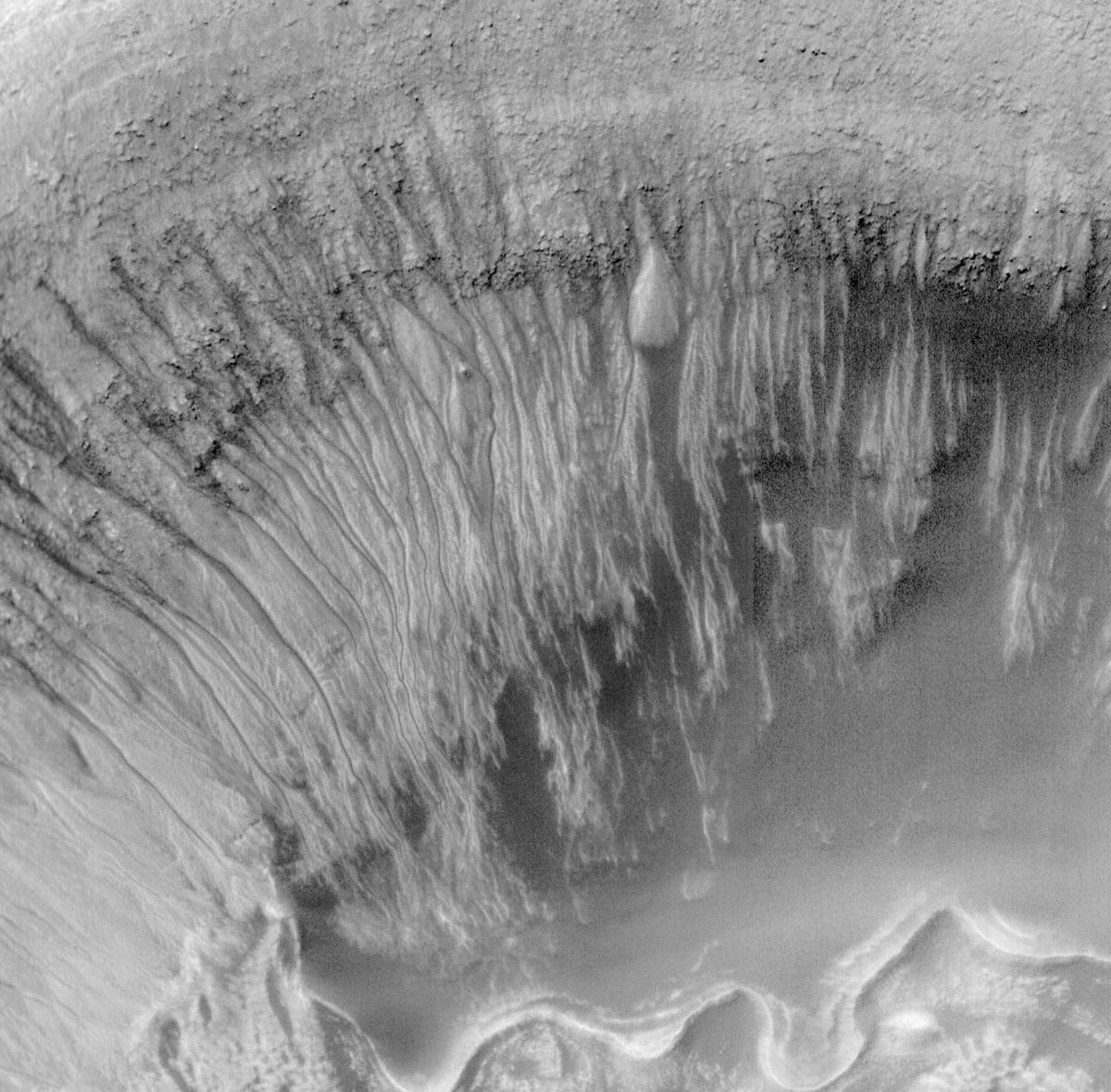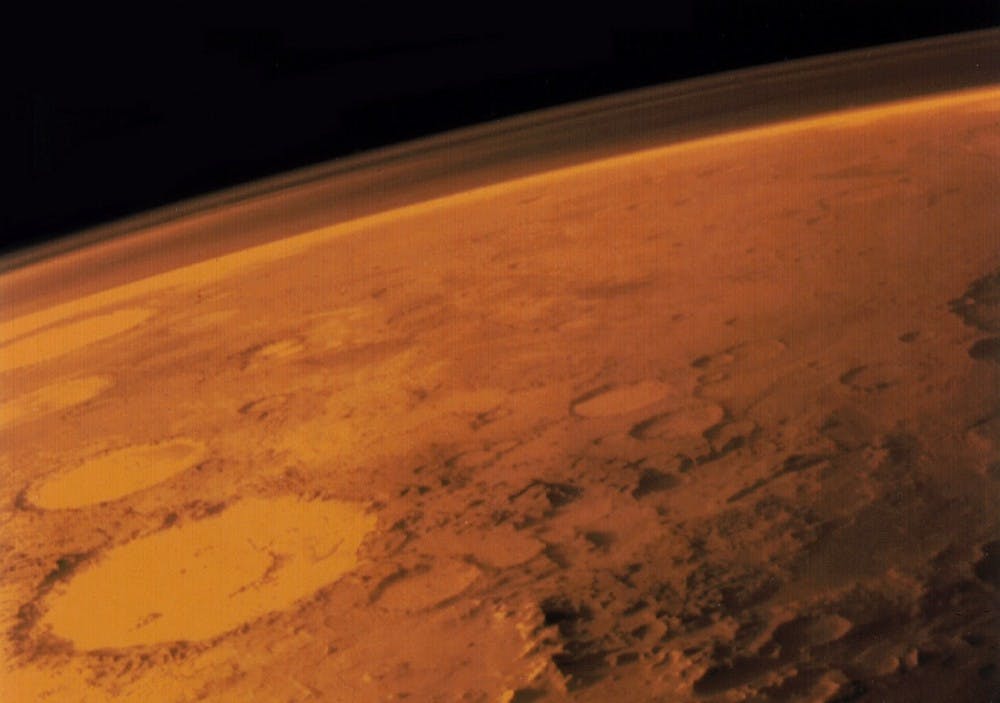By CATIE PAUL Science & Technology Editor
NASA has taken another step closer to determining whether there is life on Mars. The government organization announced on Sept. 28 that researchers had discovered liquid water on the surface of the planet.
In a morning press conference where NASA claimed “Mars Mystery Solved,” researchers outlined their discovery of salty water flows on Mars. Scientists have known for a while that Mars contains frozen water at its poles, but this is the first evidence of liquid water on the surface of the planet.
Phenomena called recurring slope lineae (RSL) appear seasonally on Mars. These dark streaks occurring on slopes of the planet disappear during cooler seasons but reappear at nearly the same location annually. Scientists have been observing the disappearance and reappearance of RSL over the past four years and now believe that they are caused by water.
Scientists believe that studying these RSL could help them learn more about the phenomena under the Martian surface.
The areas where RSL occur are also potentially the best places to look for microbial life.
The press conference revolved around a research paper about water on Mars released on Sept. 28 in Nature Geoscience. Some of the people who were remotely present at the conference included three authors of the paper, Lujendra Ojha, Mary Beth Wilhelm and Alfred McEwen.
In 2011, as an undergraduate at the University of Arizona, Ojha discovered evidence of possible saltwater flows on Mars while working with McEwen. Ojha originally noticed RSL while using computer algorithms to examine images of a crater on Mars. The team then spent a few more months trying to figure out what the dark lines on the surface could be.
Due to the darkness of the lines and their dependence on temperature the researchers suspected that they could be water. However they had no direct way to detect water until to gather more data. They found a type of salt, known as perchlorate salt, in RSL at four different locations on the planet. The only explanation for the existence of the salts is that they are produced by liquid water.
Some of the data was collected using the Compact Reconnaissance Imaging Spectrometer for Mars (CRISM). CRISM can looks for the mineral residue on Mars that could have been left behind by water. The Principal Investigator for CRISM is Scott Murchie, who works at the Johns Hopkins Applied Physics Laboratory.
Ojha stated during the press conference that pure liquid water is very unstable on Mars — it will only remain liquid from a temperature range of zero degrees Celsius to 10 degrees Celsius. However, the presence of a perchlorate solution increases the stability of water on Mars.

In addition, if the humidity on Mars becomes high enough, the perchlorates will absorb the water in the atmosphere, dissolving the salt and forming liquid water. Wilhelm offered this up as a possible explanation for the presence of liquid water on Mars.
“For the first time we have orbital evidence of the agent that has allowed water to flow on the surface of Mars,” Michael Meyer, lead scientist for the agency’s Mars Exploration Program, said.
This new discovery is changing the way scientists look at the planet.
“Mars is not the dry, arid planet that we thought of in the past,” said Jim Green, NASA’s planetary science division director. “We’re starting to put together a much more interesting picture of what Mars is like,” said John Grunsfeld, the associate administrator of NASA’s Science Mission Directorate in Washington.
Mars used to be a planet with an atmosphere and plenty of surface water, something like Earth. It once had an ocean that could have been the size of two-thirds of Earth’s northern hemisphere and as much as a mile deep. Something happened to eliminate most of that water, although scientists aren’t sure what.
The next step in discovering the mysteries of Mars may be discovering the origin of this liquid water on the surface. Ojha and colleagues are still not sure where the water comes from or how it forms. In addition scientists are still unsure of the percentage of salts in the water. Water that is too salty will be unable to support life as we know it.
Ideally the scientists would like the Curiosity rover, which is already on Mars, to take a closer look at the RSL. The rover has recently been exploring the surroundings of the Gale crater for signs that Mars was inhabitable in the past.
However, the rover cannot get too close to the water because there is a risk that microbes from Earth, carried on the rover, could contaminate the water. Because of the liquid water present in the RSL, only sterile equipment can go to these special regions.
The biggest question raised by the discovery is whether there could be life on Mars, since liquid water is a necessity for life on Earth. Some scientists are speculating that the presence of water could support microbial life, maybe under the Martian surface. Curiosity could potentially look at the streaks from a distance and use its laser to take measurements.
“Today’s announcement of a really fascinating result about current water on Mars is one of the reasons why I feel it’s even more imperative that we send astrobiologists and planetary scientists to Mars to explore the question ‘Is there current life on Mars?’” Grunsfeld said. “It’s one of the things that I find most fascinating and it excites me about coming to work every day.”
“It’s very likely, I think, that there’s life somewhere in the crust of Mars,” McEwen said.
He added, “Maybe there’s something that we can find close to the surface, and that’s what’s exciting.”
The researchers at the press conference also suggested that liquid water could potentially provide sustenance for astronauts that may visit Mars someday. In the meantime, NASA has announced that a robotic science rover headed to Mars will launch in 2020, taking advantage of the fact that the Earth and Mars will be in an advantageous position relative to each other.
“Soon, I hope, we’ll be sending humans to the Red Planet to explore, and science will lead the way,” Grunsfeld said.





